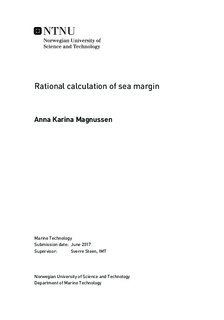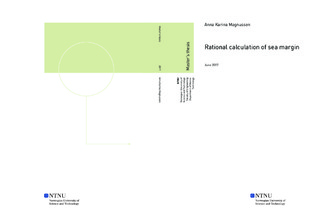| dc.description.abstract | The sea margin is an important parameter when designing a ship. The sea margin describes how much added power is required in operational conditions compared to the calm water conditions in order to maintain a speed in environmental and deteriorative effects. Traditionally a 15\% sea margin has been used, based on experience or data from similar ships.
In this thesis a method for calculating a rational sea margin has been developed and implemented. A literary study on sea margins has been performed in order to understand what progress has been made on the subject and what elements the new method should include. Parts of the method is based on elements introduced in the the literary study.
Calculation methods for the added resistance due to environmental and deteriorative effects have been reviewed in order to account for these effects in the proposed method.
A route simulation has been developed and implemented in the method. The simulation requires a route and a constant speed as input and delivers weather data for the last five years. The sea margin is calculated using this weather data, ship parameters and model test data.
The added resistance due to wind and waves are calculated using methods from the ISO 15016 standard. The effects of water temperature and density on the resistance has been evaluated. It was found that these changes represents a small difference in the overall results and were thus neglected. The deteriorative effects are represented by a fouling allowance which is assumed constant.
The method is explained in detail, with a presentation of the underlying methods and assumptions used. The method is programmed in MatLab and the thesis provides instructions on how to use it.
The proposed method was tested for a case ship in three routes using a specified constant speed. The routes defined in this thesis were from Amsterdam to New York, from Malaysia to Brazil and from Georgetown to Cape Town. The sea margins for these routes using the proposed method were found to be 18.60\%, 18.25\% and 19.81\%, respectively. These values are higher than the traditional 15\% sea margin.
Thus, a ship operating at the specified speed in these routes will have an underestimated power if the traditional sea margin is implemented.
Using measured operational data for the case ship the sea margin for the average speed was found to be 31.21\%. Using the proposed method for the same route and speed gave a corresponding calculated sea margin of 20.70\%. This indicates that the proposed method gives an underestimation of the required power in operational conditions for the case ship.
However, these results are slightly unreliable, as the case ship is operated at a constant power. Also, the effect of fouling on the actual ship is not known, which can contribute to a large increase in resistance and power. The fouling effect of the measured data is dependent on when the last hull cleaning was performed.
The sea margin is known to be speed dependent. The results from the proposed method using varying speeds have been evaluated. This showed that the added resistance margin and the sea margin both decrease with increasing speed. | |

